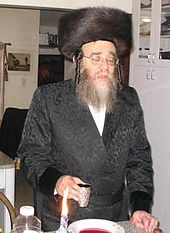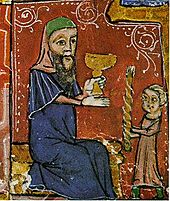|
Havdalah
 Havdalah (Hebrew: הַבְדָּלָה, romanized: haḇdālā, lit. 'separation', Jewish Babylonian Aramaic: אבדלתא, romanized: aḇdāltā) is a Jewish religious ceremony that marks the symbolic end of Shabbat and ushers in the new week. The ritual involves lighting a special candle with several wicks, blessing a cup of wine, and smelling sweet spices (Hebrew: בְּשָׂמִים, romanized: bǝśāmim, lit. '"besamim"').[1] Shabbat ends on Saturday night after the appearance of three stars in the sky.[2]: 137 If one forgot or was otherwise not able to recite Havdalah earlier, it may be performed as late as sunset of the Tuesday following Shabbat; however, when it is recited after Saturday night the blessings of the spices and candle are omitted, and only the blessings on the wine and the havdalah itself are recited.[3] Havdalah is also recited at the conclusion of the biblical holidays. Customs  Like kiddush, havdalah is recited over a cup of kosher wine or grape juice,[4] although other important beverages (chamar ha-medinah) may be used if wine or grape juice are not available.[2]: 141 Spices, called besamim in Hebrew, often stored in an artistically-decorative spice container in order to beautify and honor the mitzvah, are handed around so that everyone can smell the fragrance.[2]: 143 In many Sefardic and Mizrahi communities, branches of aromatic plants are used for this purpose, while Ashkenazi Jews have traditionally used cloves. A special braided havdalah candle with more than one wick[2]: 145 is lit, and a blessing is recited.[2]: 144 If a special havdalah candle is not available, two candles can be used, and the two flames joined when reciting the blessing.[5] Either right before or right after reciting the words "Barukh atah Adonai Eloheinu melekh ha'olam, bo're m'orei ha'esh," it is customary for the participants to hold their hands up to the candle and gaze at the reflection of the light in their fingernails.[2]: 145 This custom was first recorded in MS ex-Montefiore 134 (c. 1275)[6] and the Or Zarua II (c. 1300).[7] At the conclusion of Havdalah, some or all of the leftover wine is poured into a small dish and the candle is extinguished in it, as a sign that the candle was lit solely for the mitzvah of Havdalah; some pour directly onto the candle. Based on Psalms 19:9, "the commandment of the Lord is clear, enlightening the eyes," some Jews dip a finger into the leftover wine and touch their eyes or pockets with it. Because it was used for a mitzvah, the wine is considered a "segulah," or good omen. After the Havdalah ceremony, it is customary to sing "Eliyahu Hanavi" ("Elijah the Prophet") and/or HaMavdil Bein Kodesh LeChol ("Who separates Holy from ordinary/weekday"), and to bless one another with shavua tov (Hebrew) or a gute vokh (Yiddish), meaning "Have a good week". Havdalah is also recited at the conclusion of the following biblical holidays: Rosh Hashanah; Yom Kippur; the first days (first day in Israel) of Sukkot; Simchat Torah; Passover (Pesach), both its first and last days; and Shavuot. It is omitted, however, if the Sabbath falls immediately after the Festival. At the conclusion of a Festival that is not at the conclusion of the Sabbath, on the blessings over the wine and the blessing separating the holy from the everyday, but the spices and the havdalah candle are omitted. At the conclusion of Yom Kippur, when the blessing over the candle is recited, if it was lit from a candle that was lit all of Yom Kippur;[8] when Yom Kippur falls on a weekday, the blessing on spices is not recited, and when it falls on the Sabbath customs differ.[9] When a major holiday follows Shabbat, the Havdalah service is recited as part of the holiday kiddush and the blessing over spices is not said. The special braided Havdalah candle is not used since it may not be extinguished after the service, but rather the blessing is recited over the festival candles. The prayer "distinguishes holiness from the everyday" is changed to "distinguishes holiness from holiness" signifying that the holiness of the holiday is of a lesser degree than the holiness of the concluded Shabbat. Significance Havdalah is intended to require a person to use all five senses: feel the cup, smell the spices, see the flame of the candle, hear the blessings and taste the wine.[10] Following a normal Shabbat, the order of the prayers corresponds to the acrostic יבנ"ה Yavneh. This acrostic consists of the initials Yayin (wine), Besamim (spices), Ner (candle), and Havdalah (the Havdalah prayer).[4][2]: 140 The order of elements when Havdalah is combined with kiddush (e.g., on a Saturday night that is Yom Tov ("holiday", literally "Good Day") is known by the acrostic יקנה"ז Yaknhaz.[11] This acrostic consists of the initials Yayin (wine), Kiddush HaYom (blessing the day), Ner (candle), Havdala (the Havdala blessing) and Zman (time, i.e. shehechiyanu). Near the Qaddesh section in some Ashkenazic versions of the Haggadah (e.g. Mantoba 1560, Prague 1526, Venice 1609 and the Goldschmidt Edition),[12]: 80 there is a picture of a hunter chasing a hare.[12]: 80 This picture is a useful mnemonic for the acrostic יקנה"ז Yaknhaz as it can be described by a Yiddish or German sentence that sounds like Yaknhaz. The Yiddish sentence יאָג 'ן האָז yog 'n hoz means "hunt a/the hare!" (cf. Yiddish יאָג דעם האָז yog dem hoz). The colloquial German sentence Jag 'en Has' [jakenhaz] also means "hunt a/the hare!" (cf. German Jag einen/den Hasen!).[12]: 80–81 Blessings The verses recited before Havdalah differ by community. The introductory verses in the Ashkenazic version (beginning הנה אל, Hinei El)[2]: 140 are taken from the biblical books of Isaiah, Psalms and Esther. In the Sephardic liturgy, the introduction begins with the words ראשון לציון, Rishon L'tsion and consists of biblical verses describing God giving light and success interspersed with later liturgical prose. The Italian Nusach has a third selection of verses.[13] The verses are omitted at the conclusion of Festivals (except when coinciding with the Sabbath), when Havdalah is not recited immediately at the conclusion of the Sabbath (including when Tisha Bav falls on Sunday, and Havdalah is delayed until Sunday night at the conclusion of Tisha Bav), and in the Ashkenazic rite they are omitted also when Havdalah is recited as part of the Synagogue service. The four blessings over the wine, spices, candle and praising God for separation between holy and profane are virtually identical between the traditions. The phrase בין ישראל לעמים, bein Yisrael l'amim 'between Israel and the nations' is based on Leviticus 20:26.[14] In Reconstructionist Judaism, however, the phrase is omitted, as part of founder Mordechai Kaplan's rejection of the Biblical idea of chosenness. Modern tunes for Havdalah are based on melodies by Shlomo Carlebach, Neshama Carlebach and Debbie Friedman. The Ashkenazi liturgy for havdala after a festival or Shabbat is as follows:
See alsoReferences
External links |
||||||||||||||||||||||||||||||||||||||||||||